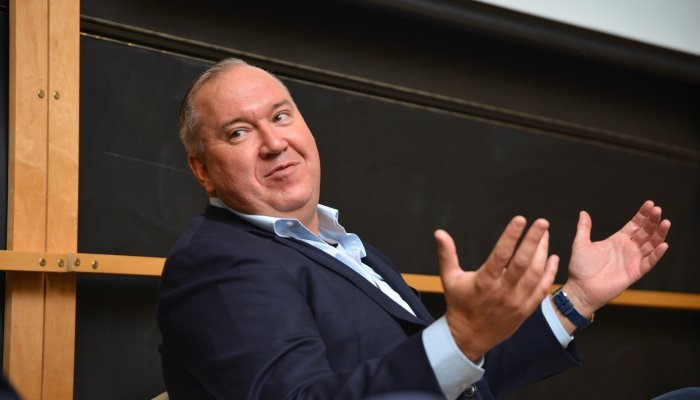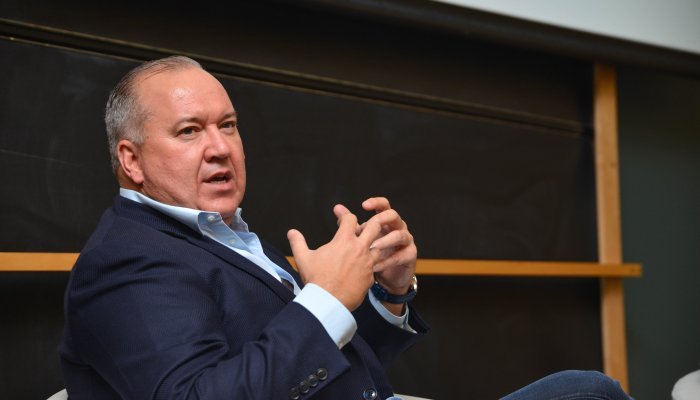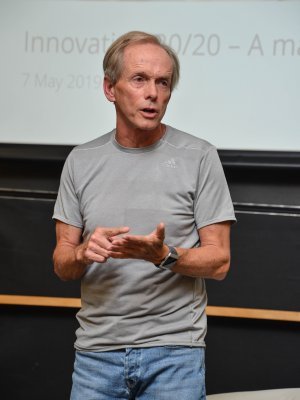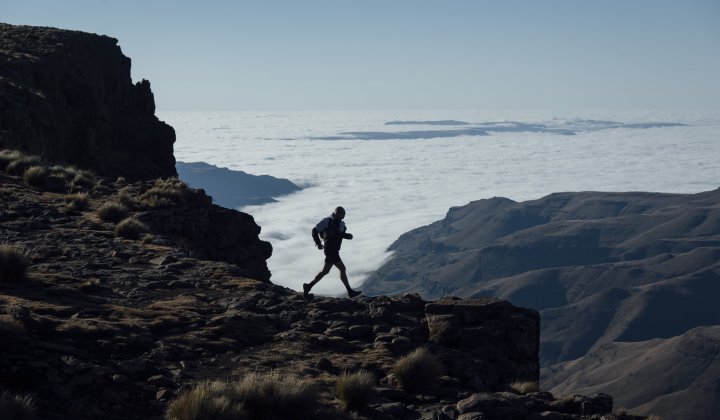Discovery is a favourite South African success story, having grown from a small specialist risk insurer to a large listed financial services group with a global presence across 21 countries and product offerings ranging from health insurance to banking. Innovation has been key to the company’s growth. However, it is arguably the innovation behind Vitality – the wellness programme that has grown to be the largest in the world with over 10 million members – that has driven the business model as a whole.
Dr. Craig Nossel, head of Vitality Wellness at Discovery and GIBS MBA alumnus, says that Vitality is arguably the world’s leading behavioural change programme driving the Discovery shared value insurance model.
Behavioural economics therefore plays a large role in everything Vitality does...
Nossel believes innovation can be developed and learnt. Facilitating the Discovery Vitality Innovation 20/20 Masterclass at GIBS, Nossel explains that Vitality, which is celebrating its 21st birthday in 2019, works on an innovation model that is driven by purpose, product, process, promotion and partners. Innovation is not an accidental occurrence, or one that only happens when inspiration strikes. Instead, it is born out of deciding exactly what you’re solving for, and having a laser focus on delivering exceptionally.
Discovery’s strong culture of innovation is built on an unwavering, upfront commitment to launching new products annually without fail, all directed at helping people to be healthier, driving the business to never rest on its laurels. Innovation is literally written into the business model.
Nossel believes any company – big or small – can develop a culture of innovation by starting with a purpose that is driven by the leadership, and matching this with the right people.
Vitality is founded on the idea that incentivising people helps them to take better decisions, whether it’s leading a healthier lifestyle, driving well or banking well. Behavioural economics therefore plays a large role in everything Vitality does, coupled with smart data analytics, technology, and the underpinning of being a purpose-driven organisation.
The results of this approach have been profound. According to Nossel, Vitality members live healthier, longer lives than comparable South Africans, and Diamond Vitality members rank among the highest longevity populations in the world.
Process innovation
Karen Johnson, head of Discovery Vitality Strategic Programmes, says that when people think of innovation, they tend to focus on product, but the process and customer experience are just as important.
She references the Doblin 10 Types of Innovation. “Product innovation relates to the final product (or service) to be sold, especially with regard to its features. Process innovation relates to the way in which a product is produced and distributed, especially with regard to improvements in cost or reliability. The product itself might be a great idea, but if it requires people to go through a complex process and overcome too many hurdles, it negates the innovation.”
As an example, she looks at the difference in two Vitality initiatives aimed at getting people to take more steps per day. An early innovation in 2004 that saw limited usage required people to purchase a manual pedometer, wear it to track the steps and have these steps recorded at a pharmacy, to earn points.
The more recent introduction of the wildly successful Apple Watch initiative simply requires users to activate the watch on the Discovery platform, download and install the app on their smartphone and get stepping. Points are automatically captured and rewards issued.
...Nando’s isn’t as pioneering as people tend to believe.
Johnson describes this as a more “magical” journey for Vitality members. The reason for its success is that it ticks all the key the boxes: product, relationship, delivery mechanism, brand, channel, partners, financial model and customer experience.
The takeaway for other businesses wanting to learn from Vitality’s success is to focus as much on the customer experience and process as the product itself. “The process for the customer needs to be simple. Any complexity should sit on the back-end,” says Johnson. “The fewer hurdles you create for the customer, the better the uptake is likely to be.”
Marketing innovation
Vitality’s marketing is rooted in three ideas: relevance (the ability to deliver the right message at the right time, to the right customer, through the appropriate channel), efficiency (the ability to reach the target audience converting at the lowest cost per point) and impact (the ability to cut through the clutter with disruptive messaging and innovative techniques).
Vitality’s marketing principles include being driven by innovation, which is about meeting client’s needs in ways they haven’t yet imagined, and focusing intensely on initiatives that will elevate the brand, rather than hedging bets through diversification.
“Building the brand involves building brand love that sustains brand value,” says Celeste Williams, head of Vitality Marketing. This means connecting with clients both emotionally and rationally.
Williams notes that much effort also goes into creating fun opportunities for people to engage with Vitality because it’s a way of making intangible products experiential. An example is the launch of Team Vitality – the largest running and cycling club in South Africa, which has enjoyed striking brand visibility at race events around the country and have been flooded with orange Team Vitality T-shirts, much to the chagrin of event sponsors.
But by far one of the most intense marketing exercises to date, Williams says, was the Vitality Open. This 10-week campaign in 2018 aimed to “bring Vitality Active Rewards to all South Africans” and to address low awareness around Vitality, generate new business for Discovery products, and test the rollout for the global Vitality network.
The campaign generated more than R100 million worth of public relations coverage. Vitality actually stopped its advertising activities halfway through the campaign as numbers had far exceeded targets. They turned their attention to focusing on engagement. Results were immense, from trending on Twitter to seeing a spike in app downloads (more than 160 000) a total of, approximately 55 000 South Africans participated.
Ask your staff to watch your customers – to see what is painful for them
The importance of partners
Throughout the masterclass, a strong theme emerged about the importance of partnerships in the success of Vitality. Three partner representatives weighed in to discuss how and why these relationships have proven so effective, and to give their perspectives on innovation.
Doug Place, Chief Marketing Officer of Nando’s, surprised the audience by saying that Nando’s isn’t as pioneering as people tend to believe. “We didn’t have a Twitter handle until 2014. You couldn’t order our food online from us until September 2018. And that’s because we believe in being the best, not always the first. You’ll see that the Nando’s fiery personality plays out even in ordering online from our award-winning app.”
He believes that at Nando’s, innovation is also internally focused. “Our founder, Robbie Brozin, always said ‘It’s the people who make the chicken.’ That’s reflected in the fact that about almost half of our marketing money is spent internally, managing how attached the 14 000 people who work for Nando’s in South Africa and the 150 000 around the world are to our brand and values. In South Africa, our labour turnover is a fraction of the industry norm. Our innovation is in the way we look after people rather than just in our products. We’re a people business, not just a restaurant.”
Ross Faragher-Thomas, MD of Virgin Active, advocates for keeping innovation simple and rooted in solving customers’ problems. “Talk more about ‘just doing things better for our customer’,” he suggests. “Push very hard the concept of observation. We become blind. Ask your staff to watch your customers – to see what is painful for them. The thing that keeps me awake at night is the thought of losing relevance. The cycle from thrive to demise is now very tight. You can’t waste time thinking about competition – you need to think how to be more relevant to your customer. Give your people an avenue to talk to you; instil that there’s no stupid idea. If you’re not getting ideas, it’s not because people don’t have them – it’s because nobody is accessible or open to them.”
Bruce Fordyce, nine-time Comrades Marathon champion and CEO of Parkrun South Africa, entertained attendees with his wit and charm as he told the story of Parkrun and its relationship with Discovery. The overlaps with Vitality are interesting – people like to be able to view and track their progress and to feel they are not alone in what they are doing.
Nossel notes that what Vitality has learned from Parkrun is that people want recognition for achieving goals (this in the context of the widely coveted Parkrun T-shirts). “We’re trying to figure out how we help people show their Vitality status,” he muses. “People want to show they have achieved diamond status. The other thing that makes Parkrun successful is scale. It has talkability and creates FOMO (fear of missing out). We’re seeing that with Active Rewards, where people see other people not paying for their coffees and smoothies, and want the same experience.”
3 keys to successful partnership:
Faragher-Thomas says the following are the most important elements for partnership:
- Both parties need to benefit – there must be enough in the arrangement for everyone.
- Relationships are key. “We make it clear that the relationship is everyone’s responsibility, at every level of the organisation. There will be bumps. But if the attitude in the leadership team is ‘it’s important and it’s going to be done’ that sets the tone. Leaders are the ambassadors in the partnership, and the various teams will follow.
- There must be alignment in values. Authenticity is important, as is trust.





















